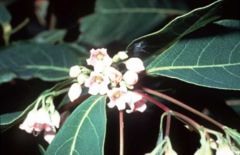Apocynum
| Apocynum subsp. var. | ||||||||||||||||||||||||||||||||||||||||||||||||||||||||
|---|---|---|---|---|---|---|---|---|---|---|---|---|---|---|---|---|---|---|---|---|---|---|---|---|---|---|---|---|---|---|---|---|---|---|---|---|---|---|---|---|---|---|---|---|---|---|---|---|---|---|---|---|---|---|---|---|

|
|
| ||||||||||||||||||||||||||||||||||||||||||||||||||||||
| ||||||||||||||||||||||||||||||||||||||||||||||||||||||||
Apocynum is a genus with about seven species, commonly known as Dogbane and Indian Hemp. The genus occurs throughout most of the temperate Northern Hemisphere, except for being absent from western Europe.
| Standard Cyclopedia of Horticulture |
|---|
|
Apocynum (Greek for dog-bane). Apocynàceae. Dog-bane. Indian Hemp. Native herbs, sometimes planted in borders. Flowers small, the calyx with acute teeth; corolla bell-shaped, with 5 appendages inside; stamens 5, inserted deep in the corolla, the filaments very short; style 0: seeds silky.—Tough perennial herbs, with milky juice, chiefly of north temperate zone, with oblong or ovate, opposite Lvs., milkweed-like fls. in small cymes, and slender follicles or pods. About 25 species, 10 native to N. Amer.
|
Cultivation
Propagation
Pests and diseases
Species
- Selected species
- Apocynum androsaemifolium (Spreading Dogbane)
- Apocynum cannabinum (Dogbane or Indian Hemp; North America)
- Apocynum hendersonii (Northern Asia)
- Apocynum pictum (Chinese Dogbane; Eastern Asia)
- Apocynum sibiricum (Siberian Dogbane; Northern Asia)
- Apocynum venetum (European Dogbane; Eastern Europe, Asia)
Gallery
-
photo 1
-
photo 2
-
photo 3
References
- Standard Cyclopedia of Horticulture, by L. H. Bailey, MacMillan Co., 1963
External links
- w:Apocynum. Some of the material on this page may be from Wikipedia, under the Creative Commons license.
- Apocynum QR Code (Size 50, 100, 200, 500)
